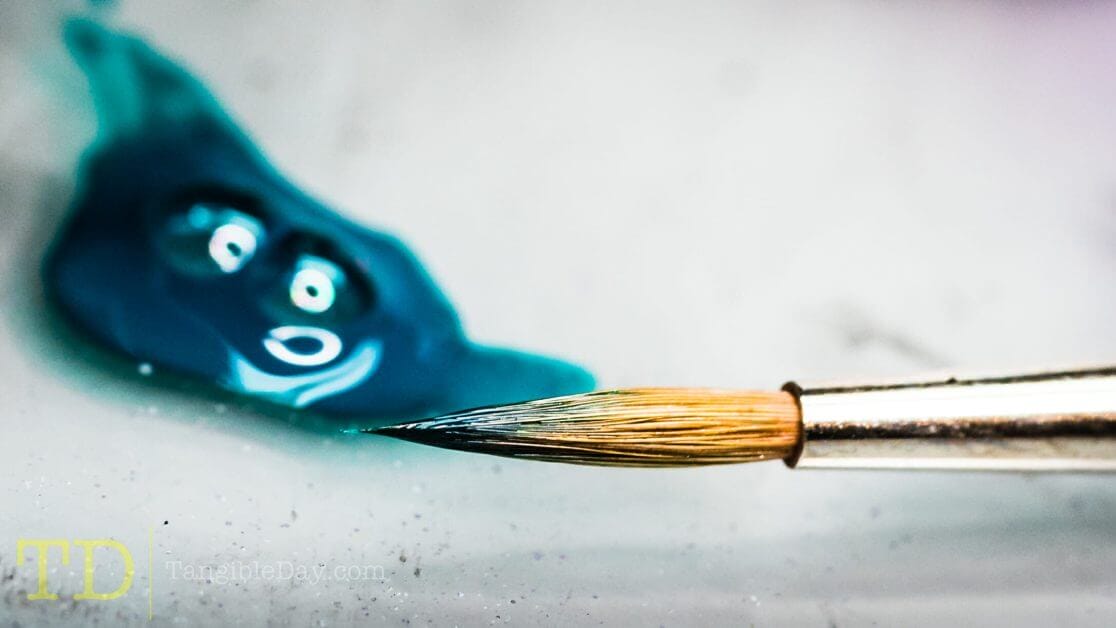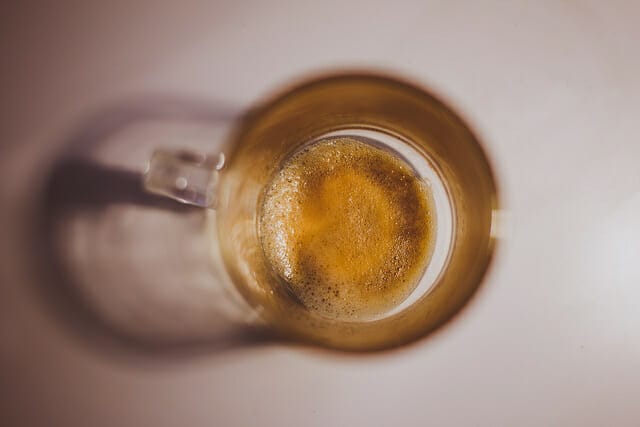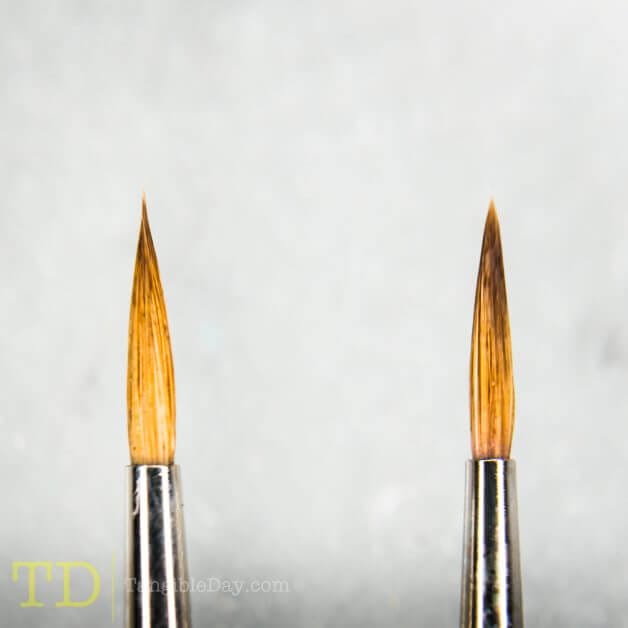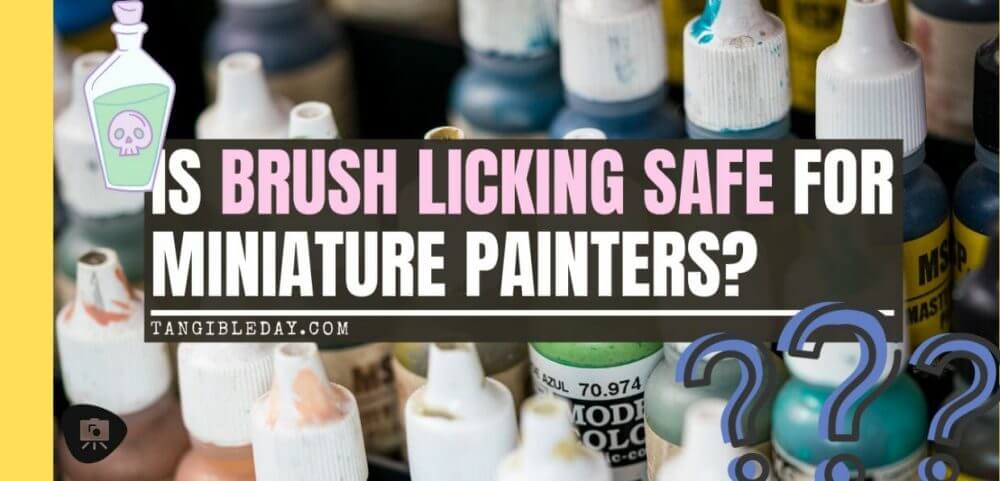Do you paint a lot of miniatures? Many miniature painters lick their brushes (see here). I’ve been guilty of doing this, too, but less so now after thinking it might be dangerous in the long-term.
But, is licking your brush really bad for you?
In this article, I try to clarify if paint brush licking is bad for you. Is acrylic paint toxic? Can you eat acrylic paint? Acrylic dangers? What happens if you eat paint? The internet is all over the place on this topic about acrylic paint. I searched for evidence and here’s what I learned. Hint: There isn’t much information about acrylic dangers or paint safety.
Summary (TL;DR): Is Brush Licking Safe or Not?
Non-toxic miniature paints (by major company brands) may be safe for accidental oral consumption by brush licking. If you lick your brushes to keep a fine point, you should be fine. Read on and see disclaimer below.**
Let’s Define Toxicity: Is Acrylic Paint Toxic?
To understand the potential danger of brush licking, we should know the definition of a toxin.

READ MORE: IS SALIVA BAD OR GOOD FOR BRUSHES?
A toxin is any chemical that alters the normal function of an organism. In our case, what we want to know is if licking our brushes with some paint on it will make us ill or lead to your death.
The medical definition of toxicity is straight-forward:
“Medical Definition of Toxicity (LD50): the amount of a toxic agent (as a poison, virus, or radiation) that is sufficient to kill 50 percent of a population of animals [or humans] usually within a certain time— called also median lethal dose.” (source 1 or source 2)
The measurement of toxicity is an LD50, or a lethal dose that can kill 50% of exposed persons. In this case, we’re talking about paint that’s on a brush in our mouth. We are concerned with toxicity through an oral route.
An important point: toxicity is dose-dependent. This means the higher amount of agent exposure, the more toxic it is.

For example, to understand the safety of coffee, you may want to know the toxicity of caffeine.
The LD50 or lethal dose of caffeine (not the coffee itself) is ~150–200mg of caffeine per kilogram (kg) of body mass. This data means that you would need to drink more than 50-100 cups of regular coffee to approach a toxic level of caffeine consumption (source). Of course, this is a broad brush, and there is more to consider, e.g., body weight, average caffeine in a cup of coffee.
Why Are My paints Labeled as “Non-Toxic”?
Many acrylic paints designed for miniature painting are non-toxic. This includes many miniature paints; including Games Workshop (Citadel Paint), Privateer Press (P3 Paint), Vallejo, Scale 75, and Reaper Miniatures (Master Series Paint, MSP).
What is the legal definition of the “non-toxic label” in the United States?
Nontoxic materials are not considered to be harmful or destructive to human health. It is to be noted that at some level, every substance is toxic. Therefore, the toxicity must be evaluated in terms of quantity of material. If the quantity of a substance that causes harm is less, its toxicity is determined to be higher (source).
This means that acrylic paints for miniatures labeled “non-toxic” can still be harmful. The risk for harm is based on your level of exposure to the paint. In other words, normal paint handling, e.g., painting a mini, paint on your skin, is considered legally safe. But, the non-toxic label does not account for unintended use, such as brush licking.
READ MORE: BEST PAINT BRUSHES FOR MINIATURES AND MODELS (COMPLETE GUIDE)
What is the Oral Dose of Paint Required to Kill a Miniature Painter?
Companies label acrylic paint products as non-toxic base this term on “normal-use”. It is fair to say that paint brush licking falls outside the normal-intended use defined by legal standards.
For an interesting article on historically dangerous brush-licking, visit here. Let’s dig deeper into the painting dose required to hurt you if you actually consume paint through licking your brush.

To do this, we can look up the Safety Data Sheets (SDS) provided for acrylic paints. Note that not every company provides these to the public through online sources.
Games Workshop, Scale 75, Privateer Press, and Reaper Miniatures do not have their SDS sheets available on the internet. But, it should be possible to get these SDS documents from these companies by contacting them directly.
By law in many countries, companies must make their product safety information, e.g., MSDS or SDS, available to consumers upon request.
Any acrylic paint that contains toxic chemicals purchased in the United States (or other developed country) will have its toxicity marked on its label or box.
Games Workshop, Scale 75, and Reaper Miniatures list almost all of their paint lines as non-toxic. Games Workshop states for its line of Citadel paint that: “All of our paints are non-toxic, water-based acrylic that are designed for use on plastic, metal, and resin Citadel miniatures.”
Vallejo is the only company of the major brands that provides an accessible safety listing with SDS documents of their paint lines (see safety info here).
MY VERDICT Based on Limited Data
To form an opinion on the topic of paint lethality, we will use the SDS LD50 safety information from one line of Vallejo paint to understand if brush licking yields any immediate lethal risk for a miniature painter.
To formulate an opinion using limited data, we must make assumptions.** For example, if all paint lines are the same formulation as Vallejo (same ingredients, such as pigments, mediums, flow improvers, etc.), then it is possible extrapolate these data and findings to the other paint brands.
Vallejo lists their safety information conveniently on their website (here). They have a listing of all their paint lines, including Vallejo Model Color, Game Color, Metallic Color, and many others.
If we pull the Model Color, Game Color, and Metallic Color SDS sheets and look at the toxicology information, this is what we get:
- Model Color = LD50 oral > 5000 mg/kg (rat)
- Game Color = LD50 oral > 2000 mg/kg (rat)
- Metallic Color = “toxicological properties…is not available.”
Model Color Paint is “less toxic” than Game Color for brush licking, because you need to consume more Model Color paint to reach its LD50. Now, when we say less toxic, we mean it has a higher dose threshold for risk (5000 versus 2000 mg/kg). Of course, the toxicology data is based on studies in rats of oral consumption, but we might expect this to be same for humans (source).
Vallejo Metallic Color paints have no toxicology information. This is kind of a warning sign that metallic paints, in general, may have hidden risks that we can’t speculate about because we don’t have enough data.
As we stated earlier, all of this data means that if you lick your brushes you’re likely not going to die in a single sitting. You can’t consume enough paint to reach the dose threshold for acutely lethal effects on your body.**
How Much Paint Can I Lick: What is the Lethal Dose of Acrylic Hobby Paint?
Let’s take Vallejo Game Color, which has an oral LD50 of 2000mg/kg (in rat or human). An average adult rat has a body mass of about 350 grams (or close to 0.35 kg).
An average adult human male or female has a body mass of 70kg (154 lbs) (source). If we do the calculations (not all shown here), a human would need to consume about 140 grams of Vallejo Game Color paint.
A typical bottle of Vallejo Game Color paint is about 17 ml liquid volume (or 26.5 grams of paint, if we calculate using the density of Vallejo Black Game Color paint – see SDS).
So, for you to have a 50% risk of dying from Vallejo Black Game Color Paint, you would need to consume via brush licking more than ~5 bottles in less than 24 hours (e.g., acute toxicity).
And, this is if you weighed 70 kilograms. If you weigh more, you could reasonably consume more than this estimate before getting to lethal levels of paint consumption.

If you are concerned with safety, please do the research and form your own opinion
This article only discusses the question of brush licking or paint consumption through an oral route in the acute setting.
In addition to using the LD50 values from the product SDS documents, there are other potential hazardous implications. But, I have not detailed these here for lack of available safety information.
Stay Informed
Importantly, the chemicals you need to avoid consuming that could be in acrylic paint brands include chromium, cadmium, cobalt, manganese, and lead.
Note that cadmium and cobalt are also parts of the names of paint colors, e.g., cobalt blue. Acrylic paints should not contain these chemicals if they carry a non-toxic label.
In addition, there are other volatile substances in paint that may pose a serious hazard (check for yourself here and here).

Final Word
To the question whether brush-licking in typical miniature acrylic painting is dangerous, the answer is scientifically “unclear”.
The article is an opinion of safety risk associated with brush licking. There are many other risky behaviors and chemicals we would be more concerned with in the miniature painting hobby (e.g., airbrushing in an enclosed space, paint thinners, aerosol primers, enamel varnishes), which carry explicit warnings. Ultimately, whether or not to engage in a particular hobby activity is a personal choice.
Non-toxic labeled acrylic paints formulated for miniature painting are likely safe if you accidentally consume paint from brush licking.
Disclaimer
Lick your brushes at your own risk.
There is no data available to assess the potential chronic toxicity or cumulative hazards associated with long-term brush-licking. Additionally, this article does not account for purposeful misuse of paint outside its intended-use, prolonged exposure to acrylic paint on any external or internal part of the body, or the actual oral consumption of acrylic paint labeled “non-toxic”.
There is also not enough scientific evidence to conclude a rigorous safety determination of brush licking due to a lack of evidence across several other dangerous health implications associated with acrylic paint exposure: These include: 1) ingestion, 2) inhalation, 3) contact with skin or eyes, 4) CMR (i.e., carcinogenicity, mutagenicity, and reproductive toxic effects), 5) sensitizing effects, 6) specific target organ toxicity (STOT) due to acute or chronic exposure, and 7) aspiration hazard.



Tangible Day on YouTube (Miniatures and More!)


There may be some mistakes in your calculations. Left a message for you.
Saw it, updated. Thank you for the message!
Pingback: This past week on the tabletop – The Campaigner
Another cool article! Glad I kept reading! Cheers Will
We found this interesting, too! Thank you for your comment.
Remember that LD50 is the median dose. That means half the people will die at a higher does, half at a *lower* dose. It’s a bell curve. The average person might drop dead at the LD50 dose, but that doesn’t mean any particular person wouldn’t die at 1/2, 1/10, or even 1/100 of that dose. Likewise a few could drink 100x the LD50 dose and survive. LD50 is a statistical average and no guarantee for any individual.
Great article, I enjoyed your reasoning and methodology. Although you very clearly state the acute scope of your analysis, I would still add that it might be prudent to highlight the possible long term (chronic) effects of ingesting paint.
I think a interesting analogy would be smoking. The acute toxic affects of cigarette smoke is rather trivial in the grand scheme of things but chronic effects can be significant. This has led many people to deem this a significant enough a risk not to start smoking. My point here is not to equate the risks of smoking to chronic heavy metal poisoning associated with paint ingestion but to merely point out that the chronic effects can be serious (and worth consideration).
In my opinion, It seems like we don’t know the risks and consequences so extra caution should be taken as a measure of “best practice”. It comes down to whether the benefit of licking your paint brush increases your quality of life or enjoyment of the activity enough to take an unknown risk.
Hi there! Thank you. I’m glad you enjoyed this. In regards to long term effects, none of the manufacturer’s did long term safety studies…but, they weren’t required to and it’s fairly expensive to run those kinds of studies. In the big scheme of things, miniature painting is a small population as compared to smoking, etc. So yep, at the end of the day, it comes down to personal choice (risk vs reward). I hoped that the article would consolidate some of the concepts and facts surrounding the act of licking a brush…I’m personally do it sometimes, and I don’t think it’s a big deal. To each their own, of course! 😀